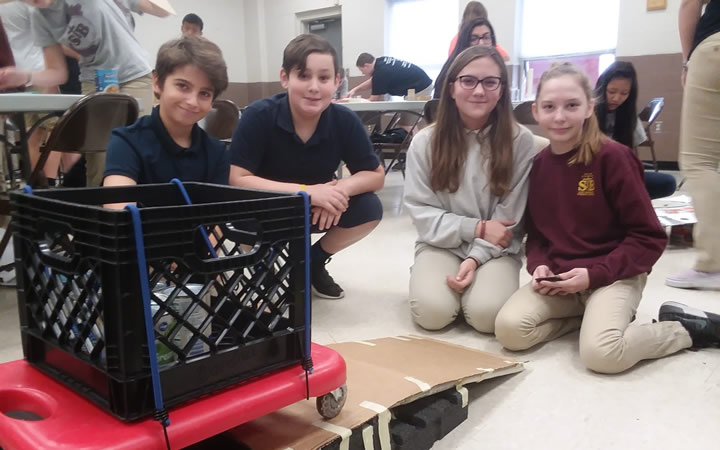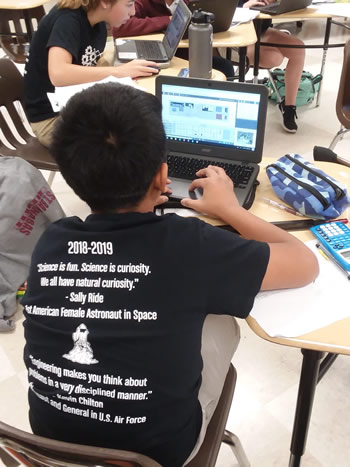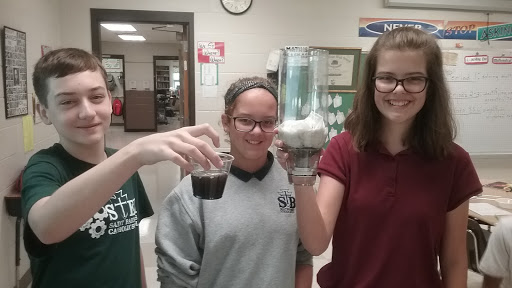How About the Non-Math and Non-Science Teachers?
Doug Bauman, Trustey Fellows Cohort 1 - St. Barnabas Catholic School in Indianapolis, IN

As a kid in the 1980s, I always had a particular love for the Kenny Rogers’ hit “The Gambler.” In that often referenced tune, Kenny imparts some very useful and worldly advice when he declares, “You got to know when to hold ‘em, know when to fold ‘em, know when to walk away, and know when to run.”
I don’t consider myself anything remotely close to a gambling man, but I have found myself heeding Kenny’s advice both inside and outside of my middle school math classroom in Indianapolis. When attempting to integrate STEM lessons into our classrooms, I would often hear the non-math and non-science teachers ask, ”How I am supposed to incorporate STEM into my curriculum? I don’t even teach math or science.” When collaborating with my teaching colleagues, at times it has truly been a poker game of sorts – figuring out which strategies to use with my fellow teachers to enable them to make rich and authentic STEM connections in all of our classrooms.
 Create A Common Understanding of STEM
Create A Common Understanding of STEM
Our Trustey Team at St. Barnabas in Indianapolis has been working together for the past four years to establish a STEM program that ignites our students’ passion for the STEM disciplines and positions them as a powerful force for good in our broader community. At the heart of our school-wide STEM initiative are our monthly STEM Days, when the entire student body engages in a rich and authentic STEM integration lesson that directly connects to at least one of their grade-level math or science standards. Building this common STEM experience offered an opportunity to welcome teachers of all disciplines, as most of the non-math and non-science teachers wanted to find natural ways to weave their subject into at least some of the STEM lessons.
Make Intentional Connections Across Disciplines
As a team, we were able to go cross-curricular only after we discussed and understood the nature of each other’s subject and learning objectives. For example, when we used a STEM lesson in which students designed a handicap-accessible ramp, we sat down with the religion teacher and examined the problem using a wide-angle lens. All the math, engineering and science aside, we brainstormed ways in which our Christian call to discipleship and Works of Mercy came into play in this STEM lesson. We realized quickly that as the students broke this problem down into smaller pieces and began to design and build their ramps, at the heart of the lesson was not the math, engineering or science. Rather, the root of this STEM lesson was our call as Christians to provide a nurturing and compassionate environment for all of God’s children. Our religion teacher was then able to have an organic discussion in her class about Christian discipleship and Catholic Social Teaching that directly connected to the STEM lesson. This STEM lesson (and others like it) quickly and powerfully became cross-curricular, and students and teachers saw the connections between the STEM disciplines and their other subjects.
Work Towards Student Engagement
This transition did not happen overnight, but the fruits of our labor have been tremendous. This year, our seventh graders used CAD software to design tiny homes for displaced victims of natural disasters. At the same time, their language arts teacher challenged them to write persuasive essays to local government officials describing the functionality and advantages of these homes. Our students also have designed and created prototypes of water filters for people in South Sudan. This project aligned with the work of the social studies teacher, who tied the lesson into the culture and demographics of the African nation.

Each of these connections was well-planned and intentional. In the end, student engagement and learning reached a higher level and the non-math and non-science teachers felt that they were now a bigger part of our school-wide STEM initiative. Together we developed a wider and deeper perspective of each other’s subject material and designed engaging STEM experiences for our all of our students.
As you journey into your own unique poker game of sorts and engage in new efforts to incorporate non-math and non-science teachers into your STEM lessons, I wish you countless blessings as you consider the cards in your hand and the strategy behind when to play them. Channel your inner Kenny and know when to hold ‘em and know when to fold ‘em.


